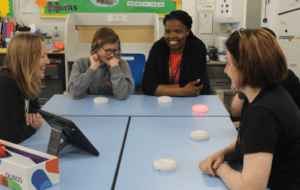What are switches?
Switches are technology that provide access to meaningful activities for people with complex

physical difficulties and/or intellectual impairments. They typically take the form of small, round buttons that you push to activate using a hand, foot, knee, head or any other controllable part of the body. Although you will most often see the round buttons, there are also switches that you can control with blinks, invisible muscle movements and even via special brain interfaces.
Wherever possible people usually use at least two switches, or prefer to have the option.
What can switches do?
Switches are amazing little things. They enable someone with the least controllable movement to play with toys, access the alphabet for writing, symbols for communication, play video games, power their wheelchair and control their smart home.
Who uses switches?
For most activities, switches are the least efficient access method because they use a system called scanning (see below). Therefore it is important to consider other more efficient access methods such as mouse, head pointer, joystick and eye-gaze before trying switches. There are some activities where switches are very efficient, but these are limited.
Many people choose to use switches in combination with other access methods. For example, eye-gaze is an efficient way to communicate indoors, but most eye trackers don’t work outside on sunny days. In these circumstances individuals often use switches as a backup.
Scanning
A switch is a very efficient way to play with an animated toy. Imagine a doggy that barks and flips when you squeeze its paw. That squeezing movement may be difficult for children with reach and grip difficulties, so a switch can used instead. We’re just substituting the standard access method (paw squeeze) for one that is accessible (switch press).
But what if you want to access more options than you have switches? If you have two available movements you might be able to access two switches, or even three or four, but not all 27 required to write using letters and the space bar.
To solve this problem switches can be configured to use a system called scanning that allows the switch user to go through each letter, in order, until they reach the one they want. At this point they press the switch. This is a very slow process – which is why it’s important to consider other access methods for this type of activity.
How to choose switches
Any part of the body can be used to activate switches, but it’s important to find somewhere that is:
- Reliable
- Repeatable
- Doesn’t cause pain or tiredness
- Practical
Finding the best position is usually a job left to occupational therapists but it’s important for everyone to consider where switches might be used by someone, i.e. what voluntary movement they have that is reliable, repeatable and doesn’t cause pain or tiredness.
Learning to use switches
Switches can be used by people with physical disabilities to participate in a wide range of activities. However, the skills required to use switches need to be learnt and therefore some support is required by adults and peers. Some people with physical disabilities also have a learning disability and may need a lot of support to learn to use switches.
Switch suppliers in the UK
The following companies make and/or supply switches in the UK.
Other useful switch sites
- Barry Ellis runs the wonderful oneswitch.org.uk website that hosts simple but age-appropriate games for switch users.
- Special Effect and EveryoneCan are charities that help switch users to access gaming.
- The NHS Environmental control services can help individuals identify switch access solutions for controlling their homes (they’ll look at other access methods too).
- The NHS Augmentative Communication services provide access assessments that will consider the use of switches for communication.
Old CENMAC helpsheets
If you’re looking for the CENMAC helpsheets from 2008 you’ll find them here:



